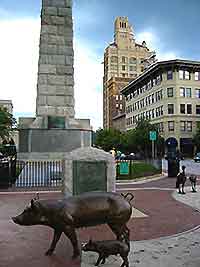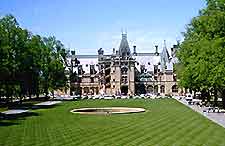Asheville History Facts and Timeline
(Asheville, North Carolina - NC, USA)

From its pioneering roots, the history of Asheville has been one of good fortune, speckled with occasional disaster.
Its pleasant location in the foothills of the Appalachian Mountains has attracted both business and resort money for decades, and today it enjoys a well-rounded reputation as one of North Carolina's liveliest economic cities and holiday destinations.
A Pioneer Arrives
It wasn't until after the American Revolutionary War that Europeans even bothered to settle in the pastoral valley of modern Asheville. Colonel Samuel Davidson was the original pioneer to build a cabin in the area in 1784. Skirmishes with the indigenous Cherokees created problems for early settlers, but over time, the sheer number of pioneers settling in the valley formed the foundation for the modern history of Asheville.
Expansion
Young Asheville received a major boost when a road following the French Broad River connected the town to Tennessee in 1828. This opened up trade with the cities to the west, which had excellent commercial ties to the rest of the country via rivers like the Mississippi.
As more roads were built into Asheville, the town became a popular place to go for health retreats and holidays. When the railroad pierced the Eastern Continental Divide, new markets to America's eastern seaboard became easily accessible and the history of Asheville really took off.

A Wealthy Resort Destination
America's wealthiest families soon discovered the beauty and tranquility of Asheville and began building holiday homes in the valley. The most famous of these was the Biltmore Estate, America's largest private residence. Built by the industrialist George Vanderbilt, this masterpiece is still a major attraction in the city and a marvel of architecture.
During the first two decades of the 1900s, Asheville enjoyed its golden era. Between local business and tourism, Asheville grew into North Carolina's third-largest city. However, that all changed with the Great Depression, which severely hit the city when eight of its main banks failed in 1930.
Modern Hub of Recreation and Culture
Even the Great Depression couldn't keep a city as beautiful as Asheville down for long. Slowly, the city began rebuilding its local economy through tourism and business, capitalizing on new national infrastructure projects like the Blue Ridge Parkway, a scenic byway that passes right through the valley.
Today's history of Asheville is being shaped by an attractive blend of outdoor recreation, annual festivals and a local culture that takes immense pride in itself. Boasting a vibrant music and art scene, several microbreweries, a dozen rivers, and easy access to miles of hiking and biking trails, Asheville is now one of the eastern United States' most popular travel hubs.
 From its pioneering roots, the history of Asheville has been one of good fortune, speckled with occasional disaster.
From its pioneering roots, the history of Asheville has been one of good fortune, speckled with occasional disaster.